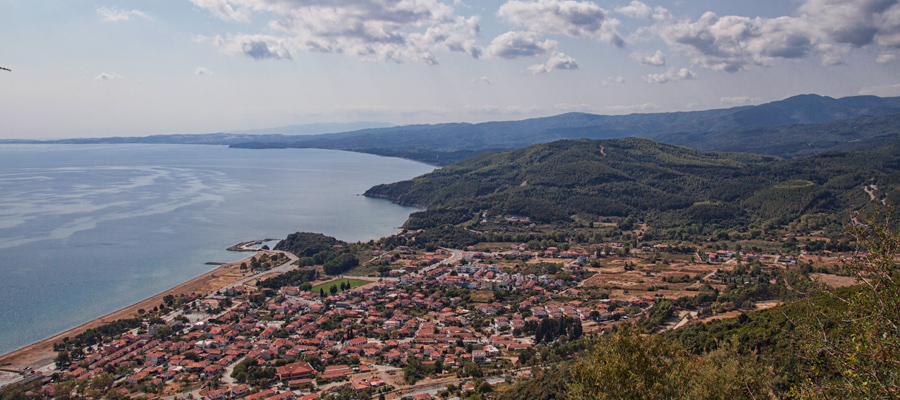«Οι κάβες της Γερακινής και το Στρατώνι…»
Ν. Καββαδίας, Φάτα Μοργκάνα
Το Στρατώνι είναι ένα παραθαλάσσιο χωριό κτισμένο στο μυχό του κόλπου της Ιερισσού, με περισσότερους από 1.200 κατοίκους (σύμφωνα με την απογραφή του 2011). Η ίδρυσή του ως οικισμού τοποθετείται στα τέλη του 19ου αιώνα και έχει άμεση σχέση με τη μεταλλευτική δραστηριότητα στην περιοχή. Τα πλούσια κοιτάσματα μεικτών θειούχων μεταλλευμάτων, γνωστά ήδη από την αρχαιότητα και τους βυζαντινούς χρόνους, αποτέλεσαν τη βασική πλουτοπαραγωγική πηγή του χωριού. Από τότε άρχισαν να συγκεντρώνονται στο Στρατώνι άνθρωποι από τις γύρω περιοχές, και από άλλα μέρη της Ελλάδας, για να δουλέψουν στα μεταλλεία. Ο πληθυσμός αυξήθηκε σημαντικά λόγω των προσφύγων που κατέφυγαν εδώ μετά τη Μικρασιατική καταστροφή. Το 1932 το χωριό υπέστη εκτεταμένες καταστροφές από το σεισμό που είχε επίκεντρο τον κόλπο της Ιερισσού. Στα αμέσως επόμενα χρόνια ανοικοδομήθηκε σχεδόν εξ ολοκλήρου.
Η περιοχή κατοικούνταν από τα αρχαιότατα χρόνια και η μεταλλευτική δραστηριότητα στο Στρατώνι και στα γύρω χωριά ανάγεται στο 600 π.Χ., περίπου. Οι ανασκαφές του 1962 έδειξαν ότι το Στρατώνι κτίστηκε στη θέση της αρχαίας Στρατονίκης. Αυτή την πόλη αναφέρει και ο Πτολεμαίος Κλαύδιος, αλλά την τοποθετεί -λανθασμένα- στο Σιγγιτικό κόλπο.
AΡΧΑΙΟΛΟΓΙΚΑ ΕΥΡΗΜΑΤΑ
Η ιστορία του τόπου αντικατοπτρίζεται στα σημαντικά αρχαιολογικά ευρήματα. Σε καλλιέργεια ιδιωτικού κήπου βρέθηκε τμήμα μαρμάρινου αναθηματικού ανάγλυφου, το οποίο φιλοξενείται στο αρχαιολογικό μουσείο Πολυγύρου και ανήκει μάλλον στους πρώιμους ρωμαϊκούς χρόνους. Πρόκειται για μετωπικά όρθια γυναικεία μορφή, ντυμένη με μακρύ χιτώνα, η οποία στο αριστερό χέρι κρατά το κέρας της Αμάλθειας και ιμάτιο. Πιθανότατα πρόκειται για αναπαράσταση της θεάς Ισιδας-Τύχης. Είναι η λεγόμενη «δέσποινα του Στρατωνίου».
Το 1962, κατά την ανόρυξη αυλάκων ύδρευσης μπροστά από το ταμείο αλληλοβοηθείας Μεταλλείων Κασσάνδρας, βρέθηκε ορθογώνιο κτίσμα 10 x 6 μ. με άξονα βορρά-νότου και είσοδο από το νότο. Αποτελείται από ένα κύριο θάλαμο 5 x 5,50 μέτρα κι έναν προθάλαμο 5 x 3 μ. που επικοινωνούν μέσω μιας πόρτας πλάτους 1,80 μ. Οι τοίχοι σώζονται μέχρι ύψους 0,80 μ. Κατά μήκος του δυτικού τοίχου βρέθηκε μια μαρμάρινη σαρκοφάγος διαστάσεων 2,20 x 0,78 μ. Στο κέντρο του βόρειου τοίχου του κυρίως θαλάμου ανακαλύφθηκε βάθρο. Μπροστά από το βάθρο βρισκόταν σε θέση πρηνή, ακέραιο άγαλμα γυναίκας ύψους 2 μ., περίπου. Μεταξύ του γυναικείου αγάλματος και της σαρκοφάγου υπήρχε ακέφαλο άγαλμα άνδρα με ιμάτια.
Βρέθηκε και τρίτος ανδρικός κορμός, καθώς και ορθογώνια πλάκα με παράσταση νεκροδείπνου με την επιγραφή «Νεικοπτελέμα Επιλύκου, ηρωίς, χαίρε» και ανδρική εικονιστική κεφαλή που ανήκει προφανώς στον κορμό εποχής των Κλαυδίων. Επίσης, μια επιτύμβια στήλη με την επιγραφή «Αφθόνητος Αρισσήδιος Τηερτέου». Σε άλλη πλάκα υπάρχει η επιγραφή «Ηρόδωρος Θεαγένους». Eντός του θαλάμου ανακαλύφθηκε κτιστός κιβωτιόσχημος τάφος και οξυπύθμενο πιθάρι που περιείχε ελάχιστα οστά. Πρόκειται, προφανώς, για κάποιο ηρώο που τοποθετείται στον 1ο αιώνα π.Χ.
Νότια του χωριού, στις πλαγιές των λόφων, επισημάνθηκαν ανοιγμένοι τάφοι ρωμαϊκής και μεταγενέστερης εποχής, καθώς και ερείπια σπιτιών. Περισυλλέχθηκαν όστρακα ελληνιστικής και βυζαντινής εποχής και λαβή αμφορέα σφραγισμένη. Από την αυλή ενός σπιτιού περισυλλέχθηκαν τέσσερα κομμάτια μαρμάρου που είχαν σπάσει πρόσφατα και αποτελούν τον κορμό ανδρικού αγάλματος.
Προς τα νότια του χωριού, στην κορυφή του πρώτου παραθαλάσσιου υψώματος το οποίο από την πλευρά της θάλασσας είναι απότομο και καλύπτεται από ελαιόδεντρα, ανακαλύφθηκε κτιστός τάφος με καμαρωτή στέγη, με πήλινους οπτόπλινθους (2,40 x 1,25 x 1,20 μ.). Στην ανατολική στενή πλευρά ανοιγόταν ορθογώνια κόγχη, η οποία περιβάλλονταν από μαρμάρινες πλάκες. Το δάπεδο αποτελούνταν από πήλινες και μαρμάρινες πλάκες. Μια πήλινη πλάκα φέρει έντυπα ορθογώνια και εντός τους από έναν εγχάρακτο σταυρό και σε κάθε γωνία του χαραγμένα ανά ένα τα γράμματα της λέξης ΘΕΟΥ. Ο τάφος ήταν γεμάτος με οστά, τα οποία ωστόσο δεν βρίσκονταν στην αρχική τους θέση.
ΠΟΛΙΤΙΣΤΙΚΕΣ ΔΡΑΣΤΗΡΙΟΤΗΤΕΣ
Οι κάτοικοι του Στρατωνίου, παρόλο που προέρχονται σε μεγάλο ποσοστό από διαφορετικές περιοχές, αποτέλεσαν ένα ενιαίο, αρμονικό σύνολο και ανέκαθεν τους διέκρινε η αγάπη για τον πολιτισμό. Σε όλη τη διάρκεια της ιστορίας, στο Στρατώνι γίνονταν πολλά καλλιτεχνικά δρώμενα και τοπικές εκδηλώσεις. Το ανέβασμα θεατρικών παραστάσεων -προπολεμικά ακόμη-, η ίδρυση μουσικογυμναστικού ομίλου από τη δεκαετία του 1950, οι εκθέσεις ζωγραφικής, η λειτουργία μπάντας και χορευτικού συγκροτήματος, η διοργάνωση εντυπωσιακών αποκριάτικων εκδηλώσεων, τα τριήμερα ειρήνης και οι συναυλίες μεγάλων καλλιτεχνών, είναι μερικά δείγματα της πολιτιστικής παράδοσης που έχει να επιδείξει το Στρατώνι. Συνεχίζεται στις μέρες μας μέσα από τη δραστηριότητα των τοπικών Συλλόγων.
ΜΟΙΡΑΣΟΥΤΟ ΑΡΘΡΟ




